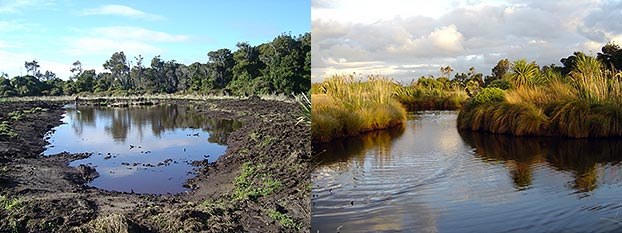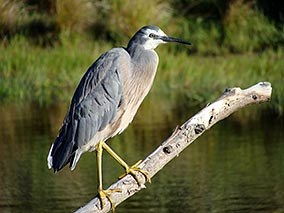If you have a naturally wet area on your property why not consider fencing it off and creating a pond. You will need to seek advice from Environment Southland and territorial councils prior to construction to see if any consents are required. Find out about the benefits of creating a pond and see our list of recommended species.
 Before and after photos of Rance’s pond.
Before and after photos of Rance’s pond.
Benefits of pond creation
There are many benefits to creating a pond and planting with native species, including:
- Providing an attractive environment for enjoyment and recreation
- Providing habitat for wildlife and attracting native birds.
Ponds planted with native plants are largely maintenance free once they have established, but you’ll need to plant the right species, which can tolerate wet conditions.
Benefits for wildlife
 White-faced heron at Rance’s pond.Ponds planted with native species help to increase biodiversity in your area. They provide habitat and food for a large range of insects and birds. Birds such as ducks, herons, stilts, kingfishers and even fernbirds can be attracted to a created pond. Perching spots over ponds help to attract birds to the pond. Together with other areas of native planting, ponds help to recreate natural habitats.
White-faced heron at Rance’s pond.Ponds planted with native species help to increase biodiversity in your area. They provide habitat and food for a large range of insects and birds. Birds such as ducks, herons, stilts, kingfishers and even fernbirds can be attracted to a created pond. Perching spots over ponds help to attract birds to the pond. Together with other areas of native planting, ponds help to recreate natural habitats.
Benefits for the farm or property
Planted pond areas can benefit your farm by:
- Protecting livestock from getting bogged
- Helping control water run-off in times of heavy rain
- Improving landscape values
- Providing a diverse habitat for native species
- Providing a recreational area.
Ecosourcing
By using locally sourced (ecosourced) native plants, you’ll use plants that are better adapted to local conditions and therefore more likely to thrive.
Ecosourcing means sourcing plants from your local area. Plants sourced from your local area are better adapted to your local conditions. They are more likely to survive and help to preserve the distinctiveness of our region.
When using ecosourced plants try to select plants from seeds collected as close as possible to where you want to plant. Contact us at the nursery for more advice about ecosourcing for your place.
Key design features
Choose plants that will tolerate wet conditions.
The diagram below illustrates the position of the native plants recommended for planting. It is important that species such as Carex and flax are planted closest to the water level as they can tolerate being totally inundated by water in times of very wet weather. The profile is equally useful for streamside plantings.
 Vegetation profile for streams, rivers and ponds.
Vegetation profile for streams, rivers and ponds.
Find out more about the plants illustrated above in the table below:
Native pond plants
| Common name | Botanical name | Plant type | Wet | Dry | Sun | Shade | Frost |
|---|---|---|---|---|---|---|---|
| 1. Carex | Carex secta |  |  |  |  |  |  |
| 2. Carex | Carex virgata |  |  |  |  |  |  |
| 6. Cabbage Tree | Cordyline australis |  |  |  |  |  |  |
| 9. Flax | Phormium tenax |  |  |  |  |  |  |
| 10. Lowland ribbonwood | Plagianthus regius |  |  |  |  |  |  |
| 7. Manuka | Leptospernum scoparium |  |  |  |  |  |  |
| 5. Mingimingi | Coprosma propinqua |  |  |  |  |  |  |
| 3. Red tussock | Chionochloa rubra |  |  |  |  |  |  |
| 11. South Island kowhai | Sophora microphylla |  |  |  |  |  |  |
| 4. Toe toe | Cortadieria richardii |  |  |  |  |  |  |
| 8. Weeping mapou | Myrsine divaricata |  |  |  |  |  |  |
Use the mouse-overs to see information about symbols.
Find out more
Contact us for more information and advice about planting around a pond at your place.
